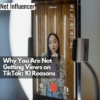Agency
How Emplicit Helps Brands Successfully Scale TikTok Shop Operations

TikTok Shop, the social media giant’s venture into online retail, is quickly becoming a powerhouse platform for growth-hungry businesses.
Emplicit is a full-service agency specializing in digital marketing that guides brands through this uncharted territory. The company’s Head of TikTok Strategy, Rafay Hussain, holds the torch.
The e-commerce entrepreneur started as a grade school teacher, though. His transition began when he and his wife built and exited several Amazon-based brands, providing him with capital and a desire for a new challenge.
The advent of TikTok caught Rafay’s attention during the COVID-19 pandemic. Intrigued by the platform’s impact on user behavior, he saw an opportunity.
Rafay’s experimentation with TikTok led to a deep understanding of the platform’s potential for driving e-commerce sales. He developed strategies for working with creators and leveraging TikTok’s advertising capabilities once they were introduced.
This expertise caught the attention of Emplicit and landed Rafay in his current role.
Rafay sees TikTok Shop as more than another sales channel. “TikTok creates demand,” he explains, contrasting it with Amazon’s role in fulfilling existing consumer needs. This distinction is driving a shift in how brands approach e-commerce, forcing them to rethink their strategies and embrace a new paradigm of social selling.
TikTok Shop is changing where people shop, discover products, and interact with brands. For businesses willing to take the plunge, the rewards could be substantial. However, success on this platform requires a nuanced understanding of its ecosystem and a willingness to adapt.
Client Base and Services
Emplicit primarily serves Amazon sellers who are expanding into TikTok Shop, with a growing clientele of direct-to-consumer Shopify brands.
“I’d say maybe 80% of Amazon brands are looking to get a full-service agency to help build up this arm for them,” Rafay says.
The company offers comprehensive Amazon services, including launch strategies, product development, conversion rate optimization, and PPC management.
For TikTok and TikTok Shop, Emplicit focuses on three main areas: borrowed traffic (influencers and affiliates), paid traffic (advertising), and owned traffic (brand-created content).
The agency distinguishes itself through a results-driven approach and honest client relationships.
“Our goal is to create raving fans,” Rafay emphasizes. “So our marketing is so word of mouth because it’s based on the results we’re getting people.”
The company prioritizes long-term client success, sometimes advising against immediate service adoption if it doesn’t align with the client’s business needs.
TikTok’s Impact on E-commerce and the Creator Economy
TikTok’s potential for e-commerce became evident through shifting user behavior.
Rafay explains, “Some of the early indicators were people are spending more time on TikTok as a platform, which typically has videos between 35 and 45 seconds per video, compared to YouTube, which has videos that are like an hour or two or ten minutes long.”
According to him, this concentration of attention presents a compelling opportunity for brands to engage with potential customers.
Rafay highlights the fundamental difference in consumer mindset between platforms: “On Amazon, you’re already solution-aware; you know what you want. For example, I might want a reusable water bottle. So, I’m going to type in a reusable water bottle. So I’m in a comparison mode.”
In contrast, “On TikTok, you’re there and just exploring… And within a 45-second video, they’re like, I need a reusable water bottle. And this is the brand that I want to buy it from.”
This shift in consumer behavior is driving changes in how brands collaborate with content creators.
Rafay observes a move away from traditional influencer marketing metrics: “The word ‘influencer’ has changed. So I even think the creators on TikTok don’t count themselves as influencers.”
He explains that TikTok’s algorithm prioritizes engaging content over follower count: “It’s built on a content ground, which means the more engaging my content is, the more distribution that content gets.”
This engagement is what Emplicit focuses on. “We want to work with creators that may not have amazing followers, but they have insane engagement,” Rafay says. “And that’s how brands I would recommend work with creators on TikTok. It doesn’t matter. The followership on TikTok is irrelevant.”
Emplicit’s approach to these collaborations relies on performance-based compensation.
“Instead of paying $5,000 for one single post, it’s like, let’s work with the creator, and let’s give them not just a flat rate, but a commission, so they get to eat what they kill as well, so to speak,” Rafay explains.
He also notes that this presents new opportunities for creators to monetize and “get off the content creation hamster wheel.”
As TikTok continues to grow as an e-commerce platform, Emplicit acts as a bridge between brands and creators.
“We talk to these creators and affiliates and create deals for them. So it’s like, ‘Hey, you have this amount of commission; this will be the flat rate, or it’s just the flat rate, smaller commission, or commission only,’” Rafay describes their role.
Emplicit’s TikTok Shop Strategy
Emplicit’s strategy encompasses multiple dimensions of product evaluation, goal-setting, and performance measurement.
The process begins with a thorough assessment of product-platform fit. “First off, we need to see if TikTok Shop is a good fit for their business,” Rafay elaborates.
He outlines three key criteria:
- Demonstrability
- Transformation potential
- Audience presence
Not all products are suitable for the TikTok Shop. Rafay provides an example: “If I’m working with a brand that sells bandages for fresh tattoos, that’s a very acute problem you want to solve at a specific time. But there’s not necessarily a passionate audience on TikTok.”
Once product-platform fit is established, Emplicit works with brands to set goals and understand their current marketing activities. “I’m diagnosing them. I’m not trying to prescribe them a cookie-cutter fit,” Rafay explains.
The launch strategy often involves a focused approach. “It doesn’t make sense to launch all 30 on TikTok. It would be better to launch one or two,” Rafay advises. This approach helps maintain a higher shop conversion rate, which is crucial on the platform.
Emplicit recognizes several challenges brands face when entering TikTok Shop.
A key issue is adapting to a new marketing approach where traditional sales tactics may not work. Rafay notes, “Customers hate being sold to. So one of the major mistakes I see is going straight for the throw, call to action, buy my thing.”
Another challenge is understanding the long-term benefits of affiliate partnerships, where a commission is only paid on the first sale. Additionally, brands must adjust their expectations for a new platform that is still changing.
To measure success, Emplicit focuses on specific metrics across three traffic categories: borrowed (influencer partnerships), paid (advertising), and owned (brand-created content).
For borrowed traffic, key metrics include creator engagement rates, outreach volume, sample requests, completed content, and paid amplification of creator content. Rafay notes, “I’m trying to see people who have 5% or above engagement with the content they’re creating.”
In paid advertising, the focus is on cost per acquisition, return on ad spend and content longevity. “I want to see how quickly my content is being exhausted,” Rafay explains. “So unlike other platforms, since the video-first platform, your creative may last two or three weeks.”
For owned content, Rafay stresses its importance in algorithm optimization: “If you have the internal capability of hiring a creator and having them create content when you have your traffic, you then help TikTok’s algorithm push your affiliates’ content to relevant people.”
The strategist highlights the synergy between these traffic sources: “All three things work in tandem,” allowing brands to quickly achieve what Rafay calls “product content market fit” and enable faster scaling on the platform.
Leveraging Analytics for Strategic Insights
Emplicit utilizes TikTok’s analytics to fine-tune strategies for its clients. Rafay reveals that he hasn’t worked on a platform “that’s this forthcoming with their internal data.”
Key metrics include creator performance data, such as GMV over 7-30 days, brand collaborations, and platform tenure.
Rafay also highlights the importance of analyzing content distribution, i.e., “the split from affiliate content versus ads versus the product card,” helping optimize resource allocation across different TikTok Shop features.
Additionally, TikTok provides valuable competitor intelligence. “They share popular keywords and subcategories that your competitors may be in, and you can quickly add that to your listing,” Rafay notes. Given TikTok’s trend-driven nature, continuously updating listings based on these insights is crucial.
For creator partnerships, Emplicit takes a balanced approach. Rather than over-scripting or allowing complete freedom, they provide a “sandbox” with key talking points and successful content examples.
Maximizing Opportunities
Rafay’s primary recommendation is to commit to a long-term strategy.
He advises, “Give your business a year’s Runway to make this channel work.” Mastering demand creation on TikTok can benefit a brand’s growth and potential exit value.
Rafay advocates leading with successful products: “Launch your hero products on that platform because there’s proof of them already working.” However, he cautions against using TikTok Shop as a clearance channel for underperforming inventory.
“Do not be stuck with one traffic bucket,” Rafay recommends, recommending a mix of borrowed (influencer), paid, and owned content. This strategy creates a “halo effect,” potentially boosting sales across other platforms like Amazon and Shopify.
Rafay highlights the current opportunity in the U.S. market, comparing the 37,000 sellers on TikTok Shop to the 9.7 million on Amazon. He notes that some brands are “scaling to millions a month within a couple of months” on TikTok Shop. While acknowledging the platform’s novelty, Rafay urges brands not to delay: “The amount of ground you can gain while all your competitors are sitting on the sideline is insane.”





















